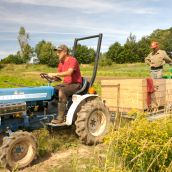Click on any of the above photos to view photo essay.
Where and how does the image of the migrant farmer appear in our pictured agricultural landscapes? This was the question that served as a focal point for Agri-Cultures, an Interdisciplinary Symposium on Trans-rural Economies, which took place at Ross Creek Centre for the Arts in Canning, NS September 18 – 20 this year. The symposium presented an opportunity for interdisciplinary dialogue on migrant farming practices in the province, and sought to open up a space for conversation about the social, political and artistic representation of agricultural labour today and in the future.
At the heart of the symposium was From Away, a photo-documentary exhibition featuring images both of and taken by migrant farmers living and working in Nova Scotia’s Annapolis Valley. These farmers have come to Nova Scotia to help tend the soil from many other places, including South America, the Caribbean and other maritime provinces.
The image of those “from away” remains distant in most instances, despite physical nearness. In what ways and for what purposes has the artistic representation of the farmer changed over the past 150 years with the spread of industrial agriculture? Where and how does the image of the migrant farmer appear in our pictured landscapes? The Agri-cultures symposium presented an opportunity for interdisciplinary dialogue on the alterity of farmers, be they migrant or otherwise.
Photographs by Ryan Buckley, Heather Cosidetto and Patrick Little
Heather Cosidetto is an artist, writer and educator and the current Program Director at Ross Creek Centre for the Arts. Cosidetto holds a BFA in Integrated Media from Emily Carr Institute in Vancouver, BC and an MA in Culture, Science and Technology from Goldsmiths University in London, England.
Ryan Buckley is a recent graduate of NSCAD with a BFA in photography and soon to pursue a degree in Photographic Preservation and Collections Management. He is currently based in Newfoundland.
Patrick Little is a BC-based artist, photographer and sculptor currently pursuing his MSc in Forest Hydrology. His photographic subjects range from landscape and habitat photography to documentation of place and the industrial and agricultural workers who shape them.






